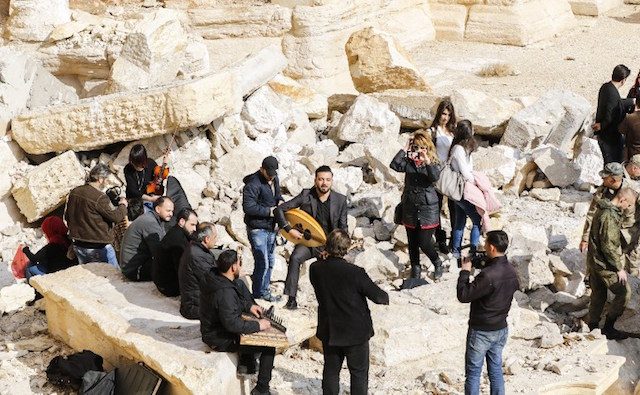SUMMARY
This is AI generated summarization, which may have errors. For context, always refer to the full article.

PALMYRA, Syria – Atop the ruins of Syria’s famed Palmyra theater, recently recaptured from the Islamic State group, teenage musician Angel Dayoub sings an old Arabic favorite: “We’re coming back, oh love, we’re coming back.”
The 15-year-old’s voice floats over the ancient Roman theater, heavily damaged then abandoned by ISIS jihadists on Thursday as Russian-backed government forces drew near.
“A little destruction won’t stop us from coming here to play and sing on this stage, despite what happened to it,” Dayoub tells Agence France-Presse.
“I want to play music and sing everywhere that has seen the expulsion of ISIS, which hates singing and banned playing instruments,” she says defiantly.
Dayoub’s rendition of Lebanese diva Fairuz’s famous song is accompanied by fellow musicians of all ages playing violins, tambourines and the oud, the pear-shaped stringed instrument beloved in the Arab world.
“We’re singing ‘We’re coming back’ because we will come back even stronger than before to rebuild Syria,” she says.
“Everyone will rebuild in their own way. We want to rebuild it with music and singing.”
The city and its ruins, designated a UNESCO world heritage site in 1980, have traded hands several times during Syria’s six-year war.
ISIS first seized Palmyra in May 2015 and began to systematically destroy and loot the site’s monuments and temples during a brutal ten-month reign.
It used the ancient theater as a venue for execution-style killings before being driven out in March 2016.
The jihadists then recaptured Palmyra in December, blowing up the tetrapylon monument and part of the theater.
ISIS ‘is darkness, music is light’
Young musicians flocked to the theater during a press tour organized by the army at the weekend, playing to an audience of dozens of Syrian and Russian soldiers.
Explosions can still be heard in the distance, as Syrian forces and their Russian allies press their offensive against ISIS north and east of Palmyra.
“Daesh (ISIS) wanted to ban us from the theater, to ban us from singing, but I want to challenge it, to beat it,” says Maysaa al-Nuqari, an oud player in her 30s.
Dressed in a black leather jacket and combat boots, her curly hair dyed a deep red, Nuqari gestures at several nearby musicians to join the jam session.
“Daesh is darkness, but music is light,” she says.
Although the precise date of its founding is unknown, Palmyra’s name is referred to on a tablet dating from the 19th century BC as a stopping point for caravans between the Mediterranean and the east.
It developed into a wealthy metropolis thanks to trade in spices, perfumes, silk and ivory from the east and became known to Syrians as the “Pearl of the Desert.”
Palmyra’s temples, colonnaded alleys and elaborately decorated tombs – some of the best preserved classical monuments in the Middle East – attracted more than 150,000 tourists a year before Syria’s conflict broke out.
‘A few scratches’
Now, the difficult task of assessing what remains of those celebrated monuments has been left to Wael al-Hafyan, who heads the engineering unit in Homs province’s antiquities department.
The 40-year-old walks through the Old City, examining various artifacts and recording his observations in a small notebook.
After a preliminary assessment, Hafyan says additional destruction is limited to the theater’s front including an arched recess behind the stage, as well as the explosion of the tetrapylon.
He broke down when he came across the theatre and the tetrapylon, once a 16-columned structure that marked one end of Palmyra’s colonnade.
ISIS reduced it to a pile of rocks in a massive explosion in January, lambasted by the UN as “a new war crime and an immense loss for the Syrian people and for humanity.”
“It’s impossible for anyone with even an iota of humanity not to feel sad when they see this. I’m sad, and I will stay sad until Palmyra goes back to the way it was,” Hafyan tells Agence France-Presse.
But with international help and UNESCO’s support, the engineer says, Palmyra can be restored.
Asked to summarize what is left of Palmyra’s renowned artifacts, Hafyan bites his lip and considers the question quietly.
“All of Palmyra is left. Palmyra’s history has remained,” he answers.
“A few scratches cannot distort its beauty. The enormity of what Daesh did here, all of its crimes, doesn’t even amount to a scratch on this beautiful, glorious face that is Palmyra.” – Rappler.com
Add a comment
How does this make you feel?
There are no comments yet. Add your comment to start the conversation.